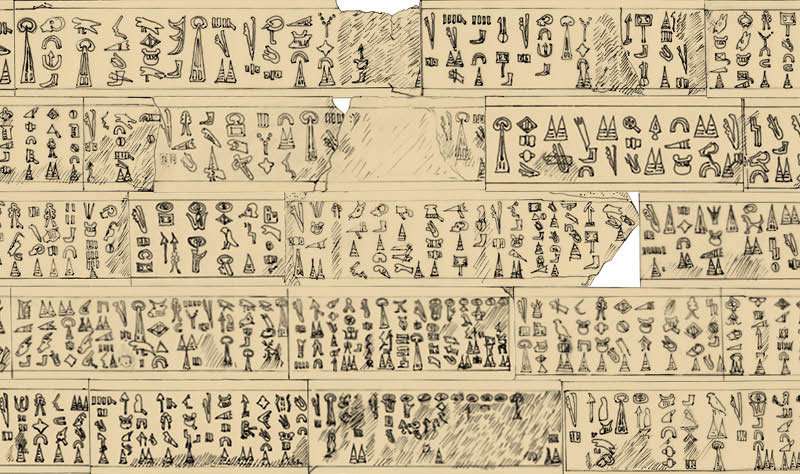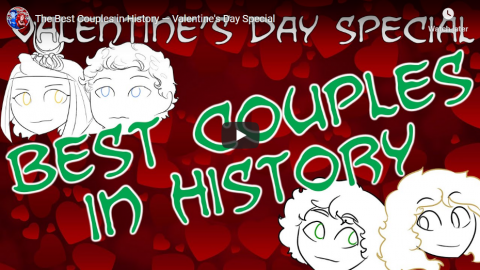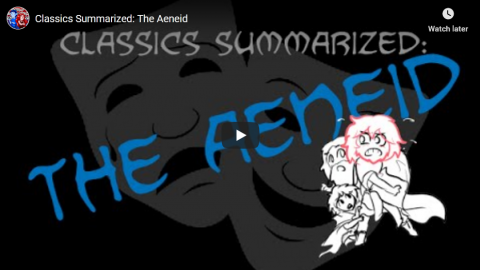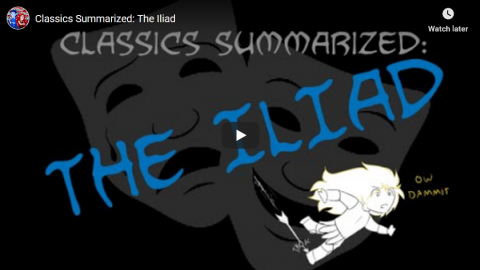Overly Sarcastic Productions
Published 14 Feb 2020Happy Valentine’s Day! Celebrate the history of Love with a rundown of these outstanding couples — for better and for worse.
Our content is intended for teenage audiences and up.
This video was edited by Sophia Ricciardi, AKA “Indigo”.
PATREON: https://www.Patreon.com/OSP
DISCORD: https://discord.gg/h3AqJPe
MERCH LINKS: https://www.redbubble.com/people/OSPY…OUR WEBSITE: https://www.OverlySarcasticProductions.com
Find us on Twitter https://www.Twitter.com/OSPYouTube
Find us on Reddit https://www.Reddit.com/r/OSP/
February 15, 2020
The Best Couples in History — Valentine’s Day Special
February 9, 2020
Classics Summarized: The Aeneid
Overly Sarcastic Productions
Published 28 Jul 2015The epic conclusion that no-one asked for! Virgil steps up to the plate and finishes the trilogy that Homer never expected to be a trilogy.
PATREON: https://www.patreon.com/user?u=4664797
Find us on Twitter @OSPYouTube!
January 28, 2020
Classics Summarized: The Iliad
Overly Sarcastic Productions
Published 23 Jan 2015I’m baaaaaaaack!
This one took me a while. The reason why should be pretty obvious. Enjoy your adorable murderfest.
Troy may be a good movie (though I have my doubts) but it sure as hell isn’t the Iliad.
PATREON: https://www.patreon.com/user?u=4664797
Find us on Twitter @OSPYouTube!
October 30, 2019
Homer, the Trojan War & the Late Bronze Age Collapse
History Time
Published 20 Mar 2018This is the first in a new series I will be producing on the Late Bronze Age Collapse.
If you enjoyed this video and would like to see more then please consider supporting me on Patreon:-
https://www.patreon.com/historytimeUK (every dollar helps)Are you a budding artist, illustrator, cartographer, or music producer? Send me a message at petekellywriter@gmail.com No matter how professional you are or even if you’re just starting out, I can always use new music and images in my videos. Get in touch! I’d love to hear from you.
I’ve compiled a reading list of my favourite history books via the Amazon influencer program. If you do choose to purchase any of these incredible sources of information then Amazon will send me a tiny fraction of the earnings (as long as you do it through the link) (this means more and better content in the future) I’ll keep adding to and updating the list as time goes on:-
https://www.amazon.com/shop/historytimeI try to use copyright free images at all times. However if I have used any of your artwork or maps then please don’t hesitate to contact me and I’ll be more than happy to give the appropriate credit.
August 11, 2019
QotD: Deconstructing “Minoan Crete”
In many ways, “Minoan” Crete seemed like a Freudian paradise. Here the archaeologists unearthed colourful frescoes of naked-breasted women participating in the dangerous “bull-vaulting” game, whilst statuettes of bare-breasted goddesses, holding writhing snakes in each hand, emerged from various parts of the island. Evans spoke glowingly of a pacifist matriarchy that flourished before the coming of the warlike and patriarchal Greeks, and his vision was hugely influential in academic circles for at least half a century. It is a vision which has been humorously outlined by Rebecca Bradley on the dust-cover of her book, Goodbye, Mother: The Warriors of Crete: “Once upon a time, on an olive-strewn island in a wine-dark sea, beautiful people lived in peace under the rule of the Great Goddess and her matriarchal avatars. The like of their palaces was not seen again until the advent of shopping-mall architecture in the twentieth century; their artistry flowered like the saffron blossoms collected by their luscious bare-breasted maidens. This was Minoan Crete, stronghold of the Matriarchy and the Great Goddess, flower child of the ancient world — until those nasty patriarchal Mycenaeans and even nastier Dorians came along and crashed the party. Oh yes, and there’s something about a volcano on Santorini, and a few earthquakes as well, but the rot really set in when the men from the mainland took over.”
Perhaps the most prominent high priestess of the Great Goddess was Lithuanian archaeologist Marija Gimbutas (1921-1994). During the 1950s and 60s Gimbutas developed her so-called “Kurgan Thesis;” basically the idea that the archaeological marker of the arrival in Europe of Indo-European-speakers was to be found in the Bronze Age Kurgan mound burials of the Pontic Steppe, a vast region incorporating most of present-day Ukraine, southern Russia and northern Kazakhstan. Controversially, Gimbutas further claimed that these nomadic Indo-Europeans brought with them a warrior-culture dominated by male sky-gods, which supplanted earlier matriarchal and goddess-worshipping cultures. In this, she echoed ideas already expressed at great length by Robert Graves in his 1948 book The White Goddess. Over the next three decades Gimbutas developed her ideas further in a series of books, articles and lectures delivered at campuses throughout America and Europe, where she was immensely influential amongst the burgeoning women’s movement. Three major works, The Goddesses and Gods of Old Europe (1974), The Language of the Goddess (1989), and The Civilization of the Goddess (1991), presented an overview of her conclusions regarding what she saw as Europe’s primeval matriarchy.
The importance of Gimbutas in the development of the matriarchal myth, and also by extension in the development of modern radical feminism, cannot be overstated. Her archaeological experience and expertise, together with her wide knowledge of linguistics and anthropology, seemed to give academic credibility to the romantic and poetic ramblings of Arthur Evans and Robert Graves. Yet in retrospect it is hard to imagine why anyone with even a modicum of common sense could have been taken in.
There were warning signals everywhere. Right from the beginning, for example, many historians were critical of Evans’ interpretation of Minoan Crete, and a devastating blow was delivered in 1974 when German author Hans Georg Wunderlich published his Wohin der Stier Europa trug? (Where did the Bull carry Europa? published in English in 1975 as The Secret of Crete). Here Wunderlich, a trained geologist, examined the structure of the “palace” of Knossos in Crete in detail and came to the conclusion that the building could never have been a palace for the living. It was, instead, a charnel house, a massive necropolis which doubled as an arena for human sacrifice. For the happy-go-lucky “bull vaulting game”, said Wunderlich, was nothing of the sort: it was a ferocious form of human sacrifice which involved young men and women being gored and trampled to death by a sacred bull. This, said Wunderlich, was the origin of the legend of the Minotaur. Since Wunderlich’s time human sacrifice has been confirmed as an integral part of Cretan religious practice, whilst the supposed “pacifism” which Evans and others had imagined, was exposed as nonsensical.
Emmet Scott, “The Myth of the Primeval Matriarchy”, The Gates of Vienna, 2016-07-13.
December 8, 2018
The Iliad – what is it really about?
Lindybeige
Published on 4 Mar 2016The Iliad – Homer’s epic poem of Achilles and the Trojan War. It was the Bible of its day, but what is it really about? Spoilers!
Support me on Patreon: https://www.patreon.com/Lindybeige
Here I summarise the plot of the Iliad, which may surprise and disappoint those who thought that it was the story of the Trojan War, and then describe and illustrate one of its main themes: the glory and tragedy of war; and then go on to point out the crucial scene of the poem, in which Priam begs for the return of the body of his son, and argue that this is actually the scene that gives meaning to the piece.
Lindybeige: a channel of archaeology, ancient and medieval warfare, rants, swing dance, travelogues, evolution, and whatever else occurs to me to make.
▼ Follow me…
Twitter: https://twitter.com/Lindybeige I may have some drivel to contribute to the Twittersphere, plus you get notice of uploads.
website: www.LloydianAspects.co.uk
March 10, 2018
Invasions of the Sea Peoples: Egypt & The Late Bronze Age Collapse
History Time
Published on 3 Sep 2017*****This was one of the first videos I ever made.******Subscribe for much better narration on the newer videos and tons more historical awesomeness*****
The years between around 1500 and 1200 BC are often cited as some of the most prosperous that the world had ever seen. The Eastern Mediterranean world inhabited by the Egyptians, the Hittites and the Minoans, as well as numerous smaller states around them, was a truly cosmopolitan system rarely seen in world history. Greek and Hittite trade goods regularly show up in archaeological sites in Egypt, whereas Egyptian hieroglyphs and trade goods are found in places such as the island of Crete and Mycenae. One shipwreck off the coast of Turkey carried goods from nine different states aboard.
As evidenced by substantial diplomatic communications as well as trade, the world of the Late Bronze Age was a vast interconnected system. The culmination of an unbroken cultural line which had existed since the first cities three thousand years before. Little did the inhabitants of these lands know however that from around 1200 BC their world would catastrophically and violently fall apart in a decades long cataclysm known as the Late Bronze Age Collapse.
Significant archaeological evidence relates that a huge number of cities and settlements were violently destroyed during the period 1210-1130 BC. In Asia Minor the mighty Hittite Empire collapsed. In Greece and the Mediterranean, the kingdoms and city states of the Mycenaean Greeks and the Minoans similarly fell apart. In Canaan and Syria vast and ancient city states were razed, with half written SOS messages written in cuneiform left to be discovered thousands of years later. In scenes reminiscent of the fall of the Western Roman Empire vast numbers of people throughout the eastern Mediterranean fled from their settlements by the shore to take refuge on fortified hill tops.
Just one of the great civilisations of the late Bronze age survived the collapse and told the tale of what happened. Egypt. Led by the Pharoah Ramesses III, often regarded as the last of the great Egyptian Pharaohs, and certainly the last New Kingdom ruler to wield any substantial authority. Inscriptions written during his reign tell of a vast coalition of warlike peoples who descended upon the civilised world during his reign, destroying it entirely and leaving just Egypt to stand alone against the coming enemy. Those enemies are known today as the Sea Peoples, and they remain one of the greatest enigmas of history.
December 2, 2017
Great Movie Fighting Techniques as illustrated by Helen of Troy
Lindybeige
Published on 31 Jan 2014This video played fine within Sony Vegas Studio, but very oddly in Windows Media Player. On YouTube it seems to be part way between the two. I just wish my videos would look and sound the way I set them in the editing software. No matter – this will have to be good enough. I have delayed uploading it too long already.
This feature film (also broadcast as a mini-series) has I think enough commentable material in it for one more video.
November 27, 2017
Sea Peoples: The 1200 BC System Collapse
Space And Intelligence
Published on 7 May 2017In the 12th century B.C., after centuries of brilliance, the civilized and globalized world of the Bronze Age came to an abrupt and cataclysmic end. Kingdoms fell like dominoes over the course of just a few decades. No more Minoans or Mycenaeans. No more Trojans, Hittites, or Babylonians. The thriving economies and cultures of the late second millennium B.C., which had stretched from Greece to Egypt and Mesopotamia, suddenly ceased to exist, along with writing systems, technology, and monumental architecture. Could it happen again?
October 15, 2017
The end of the Bronze Age
Colby Cosh linked to an article discussing a convoluted survival from about 1180BC (the image was preserved, but the work itself was destroyed in the late 19th century), which casts some light on the fall of the great Bronze Age cultures of the eastern Mediterannean:

Luwian Hieroglyphic inscription by the Great King of Mira, Kupanta-Kurunta, composed at about 1180 BC.
Credit: Luwian Studies
The 35-cm tall limestone frieze was found back in 1878 in the village of Beyköy, approximately 34 kilometers north of Afyonkarahisar in modern Turkey. It bears the longest known hieroglyphic inscription from the Bronze Age. Soon after local peasants retrieved the stones from the ground, the French archeologist Georges Perrot was able to carefully copy the inscription. However, the villagers subsequently used the stones as building material for the foundation of their mosque.
From about 1950 onwards, Luwian hieroglyphs could be read. At the time, a Turkish/US-American team of experts was established to translate this and other inscriptions that during the 19th century had made their way into the collections of the Ottoman Empire. However, the publication was delayed again and again. Ultimately, around 1985, all the researchers involved in the project had died. Copies of these inscriptions resurfaced recently in the estate of the English prehistorian James Mellaart, who died in 2012. In June 2017, Mellaart’s son Alan handed over this part of the legacy to the Swiss geoarcheologist Dr. Eberhard Zangger, president of the Luwian Studies foundation, to edit and publish the material in due course.
[…]
The inscription and a summary of its contents also appear in a book by Eberhard Zangger that is being published in Germany today: Die Luwier und der Trojanische Krieg – Eine Forschungsgeschichte. According to Zangger, the inscription was commissioned by Kupanta-Kurunta, the Great King of Mira, a Late Bronze Age state in western Asia Minor. When Kupanta-Kurunta had reinforced his realm, just before 1190 BC, he ordered his armies to storm toward the east against the vassal states of the Hittites. After successful conquests on land, the united forces of western Asia Minor also formed a fleet and invaded a number of coastal cities (whose names are given) in the south and southeast of Asia Minor, as well as in Syria and Palestine. Four great princes commanded the naval forces, among them Muksus from the Troad, the region of ancient Troy. The Luwians from western Asia Minor advanced all the way to the borders of Egypt, and even built a fortress at Ashkelon in southern Palestine.
October 10, 2017
Crap archery in Helen of Troy
Lindybeige
Published on 9 Jan 2014This film continues to be a mine of errors, and there were so many on archery, that I thought I could do a whole video on this one subject.
On the speed of arrows, I was assuming the belly of the horse to be 12 feet above the archers. The first arrow to arrive took 20 frames to get there, which is 4/5 second (PAL 25 frames per second), and 5/4 of 12 is 15, so they were travelling at about 15 feet per second.
On opposed landings, I could give the example of the British liberation of the Falkland Islands. Even though there were not vast numbers of Argentinians on the Islands, and the British had air and sea superiority, the British still chose to land unopposed the other side of the islands and walk all the way across, rather than risk an opposed landing. In the ancient world, I do not know of a successful attack on a fortified place from the sea. When the Romans cleared the Mediterranean of pirates, they did it by landing troops away from the pirate strongholds, and then marching to the strongholds overland.
www.LloydianAspects.co.uk
October 7, 2017
The Trojan War – A tale of Passion and Bloodshed! l HISTORY OF SEX
IT’S HISTORY
Published on 23 Sep 2015The Trojan War is one of the most epic and passionate legends set in Greek Mythology. Legend has it, that Prince Paris fell in love with the beautiful Helena, wife of King Menelaos of Sparta. He took her to Troy, which sent all of the rest of Greece, including the famous warrior Achilles after the city. We’ll explain which incidents on the battles are actually proven and how sex, powerplay and love is interpreted to have led to blood shed more than once during Antiquity. Join Indy for our new episode of BATTLEFIELDS!







